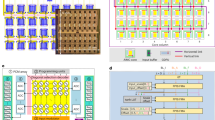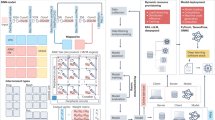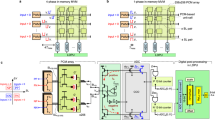Abstract
Kernel functions are vital ingredients of several machine learning (ML) algorithms but often incur substantial memory and computational costs. We introduce an approach to kernel approximation in ML algorithms suitable for mixed-signal analogue in-memory computing (AIMC) architectures. Analogue in-memory kernel approximation addresses the performance bottlenecks of conventional kernel-based methods by executing most operations in approximate kernel methods directly in memory. The IBM HERMES project chip, a state-of-the-art phase-change memory-based AIMC chip, is utilized for the hardware demonstration of kernel approximation. Experimental results show that our method maintains high accuracy, with less than a 1% drop in kernel-based ridge classification benchmarks and within 1% accuracy on the long-range arena benchmark for kernelized attention in transformer neural networks. Compared to traditional digital accelerators, our approach is estimated to deliver superior energy efficiency and lower power consumption. These findings highlight the potential of heterogeneous AIMC architectures to enhance the efficiency and scalability of ML applications.
This is a preview of subscription content, access via your institution
Access options
Access Nature and 54 other Nature Portfolio journals
Get Nature+, our best-value online-access subscription
$32.99 / 30 days
cancel any time
Subscribe to this journal
Receive 12 digital issues and online access to articles
$119.00 per year
only $9.92 per issue
Buy this article
- Purchase on SpringerLink
- Instant access to full article PDF
Prices may be subject to local taxes which are calculated during checkout



Similar content being viewed by others
Data availability
The data that support the plots within this article and other findings of this study are available at https://github.com/IBM/kernel-approximation-using-analog-in-memory-computing. The LRA dataset is available at https://github.com/google-research/long-range-arena. The datasets ‘ijcnn01’, ‘skin’, ‘cod-rna’ and ‘cov-type’ are available at https://www.csie.ntu.edu.tw/~cjlin/libsvmtools/datasets/binary.html. The datasets ‘magic04’, ‘letter’ and ‘EEG’ are available at https://archive.ics.uci.edu/datasets. The synthetic dataset is available at https://ibm.box.com/shared/static/c3brah3t04o8ruixb4m7z94e2rylsz8o.zip.
Code availability
The code used to generate the results of this study is available at https://github.com/IBM/kernel-approximation-using-analog-in-memory-computing (ref. 78).
Change history
21 January 2025
A Correction to this paper has been published: https://doi.org/10.1038/s42256-025-00996-x
References
Scholkopf, B. & Smola, A. J. Learning with Kernels: Support Vector Machines, Regularization, Optimization, and Beyond (MIT, 2001).
Hofmann, T., Schölkopf, B. & Smola, A. J. Kernel methods in machine learning. Ann. Stat. 36, 1171–1220 (2008).
Boser, B. E., Guyon, I. M. & Vapnik, V. N. A training algorithm for optimal margin classifiers. In Proc. Fifth Annual Workshop on Computational Learning Theory (ed. Haussler, D) 144–152 (ACM, 1992).
Drucker, H., Burges, C. J. C., Kaufman, L., Smola, A. & Vapnik, V. Support vector regression machines. In Proc. Advances in Neural Information Processing Systems (eds Mozer, M. et al.) 155–161 (MIT, 1996).
Schölkopf, B., Smola, A. J. & Müller, K.-R. in Advances in Kernel Methods: Support Vector Learning (eds Burges, C. J. C. et al.) Ch. 20 (MIT, 1998).
Liu, F., Huang, X., Chen, Y. & Suykens, J. A. Random features for kernel approximation: aA survey on algorithms, theory, and beyond. IEEE Trans. Pattern Anal. Mach. Intell. 44, 7128–7148 (2021).
Rahimi, A. & Recht, B. Random features for large-scale kernel machines. In Proc. Advances in Neural Information Processing Systems (eds Platt, J. et al.) (Curran, 2007).
Yu, F. X. X., Suresh, A. T., Choromanski, K. M., Holtmann-Rice, D. N. & Kumar, S. Orthogonal random features. In Proc. Advances in Neural Information Processing Systems (eds Lee, D. et al.) (Curran, 2016).
Choromanski, K., Rowland, M. & Weller, A. The unreasonable effectiveness of structured random orthogonal embeddings. In Proc. 31st International Conference on Neural Information Processing Systems (eds von Luxburg et al.) 218–227 (Curran, 2017).
Le, Q., Sarlós, T. & Smola, A. Fastfood: Approximating kernel expansions in loglinear time. In Proc. 30th International Conference on Machine Learning (eds Dasgupta, S. & McAllester, D.) III–244–III–252 (JMLR, 2013).
Avron, H., Sindhwani, V., Yang, J. & Mahoney, M. W. Quasi-monte carlo feature maps for shift-invariant kernels. J. Mach. Learn. Res. 17, 1–38 (2016).
Lyu, Y. Spherical structured feature maps for kernel approximation. In Proc. 34th International Conference on Machine Learning (eds Precup, D. & Teh, Y. W.) 2256–2264 (JMLR, 2017).
Dao, T., Sa, C. D. & Ré, C. Gaussian quadrature for kernel features. In Proc. 31st International Conference on Neural Information Processing Systems (eds von Luxburg et al.) 6109–6119 (Curran, 2017).
Li, Z., Ton, J.-F., Oglic, D. & Sejdinovic, D. Towards a unified analysis of random Fourier features. J. Mach. Learn. Res. 22, 1–51 (2021).
Sun, Y., Gilbert, A. & Tewari, A. But how does it work in theory? linear SVM with random features. In Proc. Advances in Neural Information Processing Systems (eds Bengio, S. et al.) 3383–3392 (Curran, 2018).
Le, Q., Sarlos, T. & Smola, A. Fastfood - computing Hilbert space expansions in loglinear time. In Proc. 30th International Conference on Machine Learning (eds Dasgupta, S. & McAllester, D.) 244–252 (JMLR, 2013).
Pennington, J., Yu, F. X. X. & Kumar, S. Spherical random features for polynomial kernels. In Proc. Advances in Neural Information Processing Systems (eds Cortes, C. et al.) (Curran, 2015).
Avron, H., Sindhwani, V., Yang, J. & Mahoney, M. W. Quasi-Monte Carlo feature maps for shift-invariant kernels. J. Mach. Learn. Res. 17, 1–38 (2016).
Ailon, N. & Liberty, E. An almost optimal unrestricted fast Johnson-lLndenstrauss transform. ACM Trans. Algorithms 9, 1–12 (2013).
Cho, Y. & Saul, L. Kernel methods for deep learning. In Proc. Advances in Neural Information Processing Systems (eds Bengio, Y. et al.) (Curran, 2009).
Gonon, L. Random feature neural networks learn black-scholes type PDEs without curse of dimensionality. J. Mach. Learn. Res. 24, 8965–9015 (2024).
Xie, J., Liu, F., Wang, K. & Huang, X. Deep kernel learning via random Fourier features. Preprint at https://arxiv.org/abs/1910.02660 (2019).
Zandieh, A. et al. Scaling neural tangent kernels via sketching and random features. In Proc. Advances in Neural Information Processing Systems (eds Ranzato, M. et al.) 1062–1073 (Curran, 2021).
Laparra, V., Gonzalez, D. M., Tuia, D. & Camps-Valls, G. Large-scale random features for kernel regression. In Proc. IEEE International Geoscience and Remote Sensing Symposium 17–20 (IEEE, 2015).
Avron, H. et al. Random Fourier features for kernel ridge regression: approximation bounds and statistical guarantees. In Proc. 34th International Conference on Machine Learning (eds Precup, D. & Teh, Y. W.) 253–262 (JMLR, 2017).
Sebastian, A., Le Gallo, M., Khaddam-Aljameh, R. & Eleftheriou, E. Memory devices and applications for in-memory computing. Nature Nanotechnol. 15, 529–544 (2020).
Lanza, M. et al. Memristive technologies for data storage, computation, encryption, and radio-frequency communication. Science 376, eabj9979 (2022).
Mannocci, P. et al. In-memory computing with emerging memory devices: status and outlook. APL Mach. Learn. 1, 010902 (2023).
Biswas, A. & Chandrakasan, A. P. Conv-sram: an energy-efficient sram with in-memory dot-product computation for low-power convolutional neural networks. IEEE J. Solid-State Circuits 54, 217–230 (2019).
Merrikh-Bayat, F. et al. High-performance mixed-signal neurocomputing with nanoscale floating-gate memory cell arrays. IEEE Trans. Neural Netw. Learn. Syst. 29, 4782–4790 (2018).
Deaville, P., Zhang, B., Chen, L.-Y. & Verma, N. A maximally row-parallel mram in-memory-computing macro addressing readout circuit sensitivity and area. In Proc. 47th European Solid State Circuits Conference 75–78 (IEEE, 2021).
Le Gallo, M. et al. A 64-core mixed-signal in-memory compute chip based on phase-change memory for deep neural network inference. Nature Electron. 6, 680–693 (2023).
Cai, F. et al. A fully integrated reprogrammable memristor–cmos system for efficient multiply–accumulate operations. Nature Electron. 2, 290–299 (2019).
Wen, T.-H. et al. Fusion of memristor and digital compute-in-memory processing for energy-efficient edge computing. Science 384, 325–332 (2024).
Ambrogio, S. et al. An analog-AI chip for energy-efficient speech recognition and transcription. Nature 620, 768–775 (2023).
Jain, S. et al. A heterogeneous and programmable compute-in-memory accelerator architecture for analog-AI using dense 2-d mesh. IEEE Trans. Very Large Scale Integr. VLSI Syst. 31, 114–127 (2023).
Choquette, J., Gandhi, W., Giroux, O., Stam, N. & Krashinsky, R. NVIDIA A100 tensor core GPU: performance and Innovation. IEEE Micro. 41, 29–35 (2021).
Choromanski, K. M. et al. Rethinking attention with performers. In Proc. International Conference on Learning Representations (Curran, 2020).
Browning, N. J., Faber, F. A. & Anatole von Lilienfeld, O. GPU-accelerated approximate kernel method for quantum machine learning. J. Chem. Phys. 157, 214801 (2022).
Liu, S. et al. Hardsea: hybrid analog-reram clustering and digital-sram in-memory computing accelerator for dynamic sparse self-attention in transformer. IEEE Trans. Very Large Scale Integr. VLSI Syst. 32, 269–282 (2024).
Yazdanbakhsh, A., Moradifirouzabadi, A., Li, Z. & Kang, M. Sparse attention acceleration with synergistic in-memory pruning and on-chip recomputation. In Proc. 55th Annual IEEE/ACM International Symposium on Microarchitecture 744–762 (IEEE, 2023).
Reis, D., Laguna, A. F., Niemier, M. & Hu, X. S. Attention-in-memory for few-shot learning with configurable ferroelectric fet arrays. In Proc. 26th Asia and South Pacific Design Automation Conference 49–54 (IEEE, 2021).
Vasilopoulos, A. et al. Exploiting the state dependency of conductance variations in memristive devices for accurate in-memory computing. IEEE Trans. Electron Devices 70, 6279–6285 (2023).
Büchel, J. et al. Programming weights to analog in-memory computing cores by direct minimization of the matrix-vector multiplication error. IEEE J. Emerg. Sel. Top. Circuits Syst. 13, 1052–1061 (2023).
Vovk, V. in Empirical Inference: Festschrift in honor of Vladimir N. Vapnik (ed. Schölkopf, B. et al.) Ch. 8 (Springer, 2013).
Vaswani, A. et al. Attention is all you need. In Proc. Advances in Neural Information Processing Systems (eds Guyon, I. et al.) (Curran, 2017).
Chen, M. X. et al. The best of both worlds: combining recent advances in neural machine translation. In Proc. 56th Annual Meeting of the Association for Computational Linguistics (eds Gurevych, I. & Miyao, Y.) 76–86 (ACL, 2018).
Luo, H., Zhang, S., Lei, M. & Xie, L. Simplified self-attention for transformer-based end-to-end speech recognition. In Proc. IEEE Spoken Language Technology Workshop 75–81 (2021).
Parmar, N. et al. Image transformer. In Proc. 35th International Conference on Machine Learning (eds Dy, J. & Krause, A.) 4055–4064 (JMLR, 2018).
Tay, Y., Dehghani, M., Bahri, D. & Metzler, D. Efficient transformers: a survey. ACM Comput. Surv. 55, 1–28 (2022).
Katharopoulos, A., Vyas, A., Pappas, N. & Fleuret, F. Transformers are RNNs: fast autoregressive transformers with linear attention. In Proc. 37th International Conference on Machine Learning (eds Daumé, H. & Singh, A.) 5156–5165 (PMLR, 2020).
Peng, H. et al. Random feature attention. In Proc. International Conference on Learning Representations (Curran, 2021).
Qin, Z. et al. cosformer: Rethinking softmax in attention. In Proc. International Conference on Learning Representations (Curran, 2022).
Chen, Y., Zeng, Q., Ji, H. & Yang, Y. Skyformer: remodel self-attention with gaussian kernel and nyström method. In Proc. Advances in Neural Information Processing Systems (eds Beygelzimer, A. et al.) 2122–2135 (Curran, 2021).
Joshi, V. et al. Accurate deep neural network inference using computational phase-change memory. Nature Commun. 11, 2473 (2020).
Büchel, J., Faber, F. & Muir, D. R. Network insensitivity to parameter noise via adversarial regularization. In Proc. International Conference on Learning Representations (2022).
Rasch, M. J. et al. Hardware-aware training for large-scale and diverse deep learning inference workloads using in-memory computing-based accelerators. Nature Commun. 14, 5282 (2023).
Murray, A. F. & Edwards, P. J. Enhanced MLP performance and fault tolerance resulting from synaptic weight noise during training. IEEE Trans. Neur. Netw. 5, 792–802 (1994).
Tsai, Y.-H. H., Bai, S., Yamada, M., Morency, L.-P. & Salakhutdinov, R. Transformer dissection: a unified understanding for transformer’s attention via the lens of kernel. In Proc. Conference on Empirical Methods in Natural Language Processing and the 9th International Joint Conference on Natural Language Processing (eds Inui, K. et al.) 4344–4353 (ACL, 2019).
Li, C. et al. Three-dimensional crossbar arrays of self-rectifying si/sio2/si memristors. Nat. Commun. 8, 15666 (2017).
Wu, C., Kim, T. W., Choi, H. Y., Strukov, D. B. & Yang, J. J. Flexible three-dimensional artificial synapse networks with correlated learning and trainable memory capability. Nat. Commun. 8, 752 (2017).
Le Gallo, M. et al. Precision of bit slicing with in-memory computing based on analog phase-change memory crossbars. Neuromorphic Comput. Eng. 2, 014009 (2022).
Chen, C.-F. et al. Endurance improvement of ge2sb2te5-based phase change memory. In Proc. IEEE International Memory Workshop 1–2 (IEEE, 2009)
Chang, C.-C. & Lin, C.-J. IJCNN 2001 challenge: generalization ability and text decoding. In Proc. International Joint Conference on Neural Networks 1031–1036 (IEEE, 2001).
Slate, D. Letter recognition. UCI Machine Learning Repository https://doi.org/10.24432/C5ZP40 (1991).
Bock, R. MAGIC gamma telescope. UCI Machine Learning Repository https://doi.org/10.24432/C52C8B (2007).
Roesler, O. EEG Eye state. UCI Machine Learning Repository https://doi.org/10.24432/C57G7J (2013).
Uzilov, A. V., Keegan, J. M. & Mathews, D. H. Detection of non-coding RNAs on the basis of predicted secondary structure formation free energy change. BMC Bioinformatics 7, 1–30 (2006).
Bhatt, R. & Dhall, A. Skin segmentation. UCI Machine Learning Repository https://doi.org/10.24432/C5T30C (2012).
Tay, Y. et al. Long range arena: a benchmark for efficient transformers. In Proc. International Conference on Learning Representations (Curran, 2021).
Paszke, A. et al. Pytorch: an imperative style, high-performance deep learning library. In Proc. Advances in Neural Information Processing Systems (eds Wallach, H. M. et al.) 8024–8035 (Curran, 2019).
Hoerl, A. E. & Kennard, R. W. Ridge regression: biased estimation for nonorthogonal problems. Technometrics 12, 55–67 (1970).
Ott, M. et al. fairseq: a fast, extensible toolkit for sequence modeling. In Proc. Conference of the North American Chapter of the Association for Computational Linguistics (Demonstrations) (eds Ammar, W. et al.) 48–53 (2019).
Lefaudeux, B. et al. xformers: a modular and hackable transformer modelling library. GitHub https://github.com/facebookresearch/xformers (2022).
Rasch, M. J. et al. A flexible and fast PyTorch toolkit for simulating training and inference on analog crossbar arrays. In Proc. 3rd International Conference on Artificial Intelligence Circuits and Systems 1–4 (IEEE, 2021).
Gallo, M. L. et al. Using the IBM analog in-memory hardware acceleration kit for neural network training and inference APL Mach. Learn. 1, 041102 (2023).
Reed, J. K. et al. Torch.fx: practical program capture and transformation for deep learning in Python. In Proc. of Machine Learning and Systems (eds Marculescu, M. et al.) Vol. 4, 638–651 (2022).
Büchel, J. et al. Code for ‘Kernel approximation using analog in-memory computing’. GitHub https://github.com/IBM/kernel-approximation-using-analog-in-memory-computing (2024).
Acknowledgements
This work was supported by the IBM Research AI Hardware Center. A.S. acknowledges partial funding from the European Union’s Horizon Europe research and innovation programme under grant no. 101046878 and from the Swiss State Secretariat for Education, Research and Innovation (SERI) under contract no. 22.00029. We would also like to thank T. Hofmann for fruitful discussions.
Author information
Authors and Affiliations
Contributions
J.B. and G.C. set up the infrastructure for training and evaluating the various models. J.B., G.C., A.V. and C.L. set up the infrastructure for automatically deploying trained models on the IBM Hermes project chip. J.B. and G.C. wrote the paper with input from all authors. A.R., M.L.G. and A.S. supervised the project.
Corresponding authors
Ethics declarations
Competing interests
The authors declare no competing interests.
Peer review
Peer review information
Nature Machine Intelligence thanks Parthe Pandit and the other, anonymous, reviewer(s) for their contribution to the peer review of this work.
Additional information
Publisher’s note Springer Nature remains neutral with regard to jurisdictional claims in published maps and institutional affiliations.
Supplementary information
Supplementary Information
Supplementary Tables 1–4 and Notes 1–4.
Rights and permissions
Springer Nature or its licensor (e.g. a society or other partner) holds exclusive rights to this article under a publishing agreement with the author(s) or other rightsholder(s); author self-archiving of the accepted manuscript version of this article is solely governed by the terms of such publishing agreement and applicable law.
About this article
Cite this article
Büchel, J., Camposampiero, G., Vasilopoulos, A. et al. Kernel approximation using analogue in-memory computing. Nat Mach Intell 6, 1605–1615 (2024). https://doi.org/10.1038/s42256-024-00943-2
Received:
Accepted:
Published:
Issue date:
DOI: https://doi.org/10.1038/s42256-024-00943-2
This article is cited by
-
Kernel approximation using analogue in-memory computing
Nature Machine Intelligence (2024)



